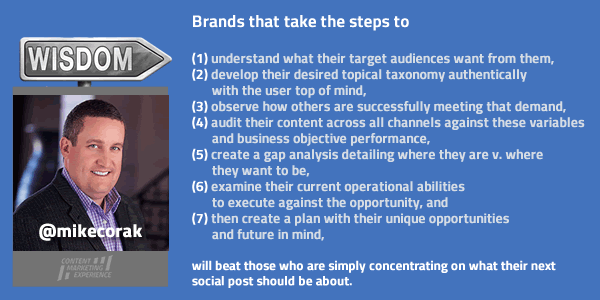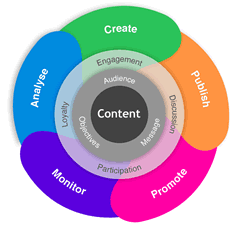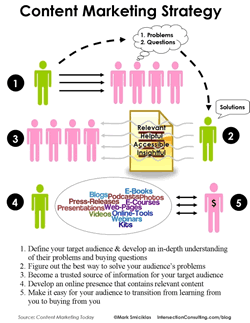You need a content marketing strategy. That’s what everyone tells you. So, why do you need a content marketing strategy and how do you get started? In plain and simple English (I hope).
As a marketer normally you’re accountable and have a duty and goals to accomplish. That’s why before spending money you develop a plan and a strategy. In this case a content marketing strategy. Surprise – not really: organizations with a formal plan or content marketing strategy do better.
A strategy brings you from A to Z. Furthermore, as you’re probably not alone in the organization it allows others to go from A to Z with you as normally you share the same goals. Other marketers, sales people, customer service reps, you name it. Probably you also have a boss who wants to know whether you accomplish your goals or not. A good one will even want to know what those goals are and how you hope to get there without all the jargon. And he or she will also want to stay in the loop about your progress.
The essence of a content marketing strategy: ((A to Z) x 2 – (weird moves of prospects))
You have customers and – prospective – customers. And they have people they trust when they want to buy something. They take decisions. And they also move from A to Z whereby Z is far beyond the actual buy.
However, your customers move from A to Z in different ways than you do. And not all customers behave the same. Some move from A to G and then back to B before returning to G and suddenly going from G to Z. Others will even come in at B, exit at H and never come back. Customers/prospects/people can make unexpected moves indeed and it isn’t always like the simple model depicted (and is not really serious).

So, to connect all those dots you need a strategy. And that’s why you need a content marketing strategy – or strategic approach to content marketing – too.
It’s so important there are books such as ‘Managing Content Marketing‘, written by Robert Rose and his friend Joe Pulizzi.
Lee Odden wrote “Optimize“, a book on content marketing in this digital age, where content marketing is part of a mix including social media and search, wrote a review of ‘Managing Content Marketing‘ a while back. You can read it here.
Content marketing and the customer journey
Enough books, let’s try to continue our plain English content marketing strategy journey. Content marketing is about using content in a planned and strategic way to fulfill different business goals.
The best way to achieve that is by knowing your customers and prospects and by having “contact moments” with them on the Web and elsewhere. Some of those contact moments are between you and a prospect or customer in a direct way, for instance when someone comments on a blog post or replies to a mail you sent.

Others are indirect, for instance when someone reads your white paper. The latter are very common on the Web. The goal is to move from indirect contacts to more direct ones. If someone downloads that white paper you can say hi and thank you before doing more. Because now you also know a bit more about who they are, if you used a form for instance, and check out whether they’re interested in the paper as such or if they are actually on the market to buy at any given time. Or in other words: see where they are in their A to Z. If they’re still at A they need a bit more work and will maybe even never get to Z or get there without you knowing it until they have arrived. If they’re at Q, then you better get even more direct.
Those initial and following contact moments can happen anywhere between A and Z and the first goal is that prospects learn that you exist to start with. If they already know you exist they can decide that what you do and what you provide across those contact moments – often content – is interesting, relevant or just cute for them.
Cute can ultimately lead to sales. Relevant more often leads to sales. Useful (Youtility, indeed) leads to long-lasting relationships when focusing on mutual value.
When during different contact moments people are effectively prospects and in a buying mood, then you better be very relevant, in real-time and in context. Relevant means that the content in your A to Z at that time matches the right letter in your prospect’s or customer’s A to Z. And finding those magic moments is a lot what content marketing and marketing in general are all about. So, it’s pretty obvious it also matters in a content strategy. But always in an integrated way.
Content marketing strategy: two less plain English words
A content marketing strategy assumes that content marketing is approached in a customer-centric, connected, planned and strategic way. I promised plain English. So let me translate two terms:
- Customer-centric basically means that you organize your business and marketing in function of what potential customers find interesting, relevant or just cute. As not all customers are the same, customer-centric also means that you need a few plans to make sure that those different ‘types’ of customers like and what makes them act. That’s what all the talk regarding buyer personas, segments and more advanced stuff is about.
- Connected means that content marketing is part of your marketing overall. I guess that sounds obvious. It’s also hard to distinguish content marketing from other forms of marketing. That’s because content marketing essentially is a term for what many folks have been doing for a long time. That’s a known fact. The only reason we all call it content marketing now is because the term is so popular that people like me have to use the term content marketing to describe what we were doing. Why? Because some of our potential customers are looking for content marketing services and advice. And saying no to those potential customers because they use the term content marketing would be quite silly, wouldn’t it? As customers are people they are also connected so they pick up these terms.
The steps and considerations in a content (marketing) strategy
OK, so let’s look at the different elements of the content strategy now because essentially you know all you need to know to develop a content (marketing) strategy. And, in the end it isn’t really that different from, let’s say developing a…marketing strategy.
Except for the fact that you will probably also have to collaborate with other people to get the right content to get the job done. All the rest you already know. Planning: been there, done that, in all forms of marketing. Understanding the different customers and what makes them tick (act, buy): even the local baker knows that this is important.
So, here, before starting a more ‘complex’ and in-depth series (based on real life instead of theory) on all the strategic elements of content marketing, are the main steps in your content (marketing) strategy:
Have a reason to start using content marketing.
Or better: content across your marketing and customer service efforts. Yes, you need a few goals. That’s your A to Z.
And since the boss is watching and as marketers we have a duty we also need to have numbers to see if we’re taking the right decisions. If we’re not taking the right decisions we might lose support from the boss, respect from sales, the love of our customers and even a few thousand employees if we take really bad decisions. Knowing what the reason and purpose is will also avoid that in a few years from now people will say content marketing doesn’t work. It’s like in social media: people start saying it doesn’t work because they often forgot to think about for what and whom they wanted it to work in the first place (and because they sometimes also forgot the following steps).
Know your audiences, customers, prospects and stakeholders
Know how they “act”, what they want and use your content (marketing) strategy to write all that down.
Ideally, be really customer-centric and ask what they want, watch what they want and do, and even invite them around the table for a cup of coffee and some involvement. By focusing on how they move from THEIR A to Z and seeing what role content plays in it, you can match that with YOUR A to Z. The secret is a ‘connected customer experience’, which allows you to look at touchpoints in a customer-centric and integrated/connected way like we do in marketing automation where content marketing has been used intensively for a very long time. Oops, that wasn’t plain English.
See what you have (and it’s often closer than you think).
As a responsible person you don’t want to spend more money than you need. Remember those poor souls that might lose their job. Or think about your own future career. The boss usually dislikes wasted money.
So start by looking what you already have to grab potential customers by the hand, wherever they are (they need to know you exist but also think about you when it matters) and take them from A to Z. Also look at all the other letters in between or you might lose their attention somewhere between K and Q. That would be a waste of energy. Tip: in many cases the best way to go from A to Z is by taking the A to Z of your customers into account. Tip 2: the best content for your customers and business already is in the heads of your customers and the people in your business. The latter are often called subject matter experts. You just need to get it out of their heads and present it in something everyone understands.
See what you don’t have (but need).

Once you identified what you have (and you may need to rework and promote it a bit more because customers don’t always hear or see you the first time and they have different contact moments), you know what you don’t have but need.
So you look at the best and most effective ways to get it, create it and make it found. Of course always keeping the big content (marketing) strategy and your overall plan in mind.
Get it organized.
When you want some of the content you found reworked or want new content to be at your customer’s best service (and that of your boss, colleagues, friends, etc.) you also will have to plan a bit.
Probably you’re not writing, making white papers, doing marketing, selling, servicing customers and all that on your own. So it makes sense to apply the basic rules of project management, this time around all the stuff that happens in content marketing. This also includes some sort of scheduling on top of collaboration, some processes, etc. After all, you’ll need new customers in a year or so as well. And you also want to keep the customers you have, for instance by helping them use your products better using…content. As a responsible and smart business person you know that happy customers bring new ones. Just ask the local baker. So, on top of the essential content your A to Z and that of your prospect/customer need, you want to schedule over time, connecting what people find cute/relevant (ideally your prospects and customers) and what you are all about (ideally in business).
Check out the best formats and channels.
You also want to check out the different formats of content your prospective customers use and there are some good tips and tricks to make sure that your content is what we call “engaging”.
Most of them were invented a long time ago but on the Web all those channels people use have their own little rules and typical usage scenarios. So you will have to take a bit of training into account as well and if there is one particular channel or source of information your customers and prospects really use a lot (or more), you can even develop a strategy for that too. You’ll have to make sure that the content is found or used. If not there is little sense in spending all the energy, is there? You’ll notice quickly that a connected approach usually works best, for instance connecting and integrating content marketing, social and search like Lee Odden describes is his earlier mentioned book ‘Optimize’ and like I’m trying to say with many others for many years now in an overall marketing context.
Test (and measure and optimize – continuously).
If it doesn’t work your boss won’t be happy. And your customers might even be upset. Or your partner if you don’t land that bonus. To avoid that it’s best to test and measure before all the money is spent. That also allows you to change your strategy. As no strategy is ever perfect. Read that again and taste the words: no strategy is ever perfect.
There are much more content marketing strategy resources and tips such as this blog post, where we found the nice image in the beginning of this blog post. Simply search for ‘content marketing strategy’ in Google. Or check out a more in-depth introduction to content marketing strategy. Or type ‘content marketing strategy’ in our own little search box.
But always remember the basics in plain English before drifting away in an ocean of theories.
And of course there are all the mentioned books, great blogs on content marketing (we made a list here), smart content marketing folks (another list) and probably some less plain English stuff on this site too.
Ready for more? Here’s an overview of 7 steps to content marketing success including more content strategy and measurement links and tips.

